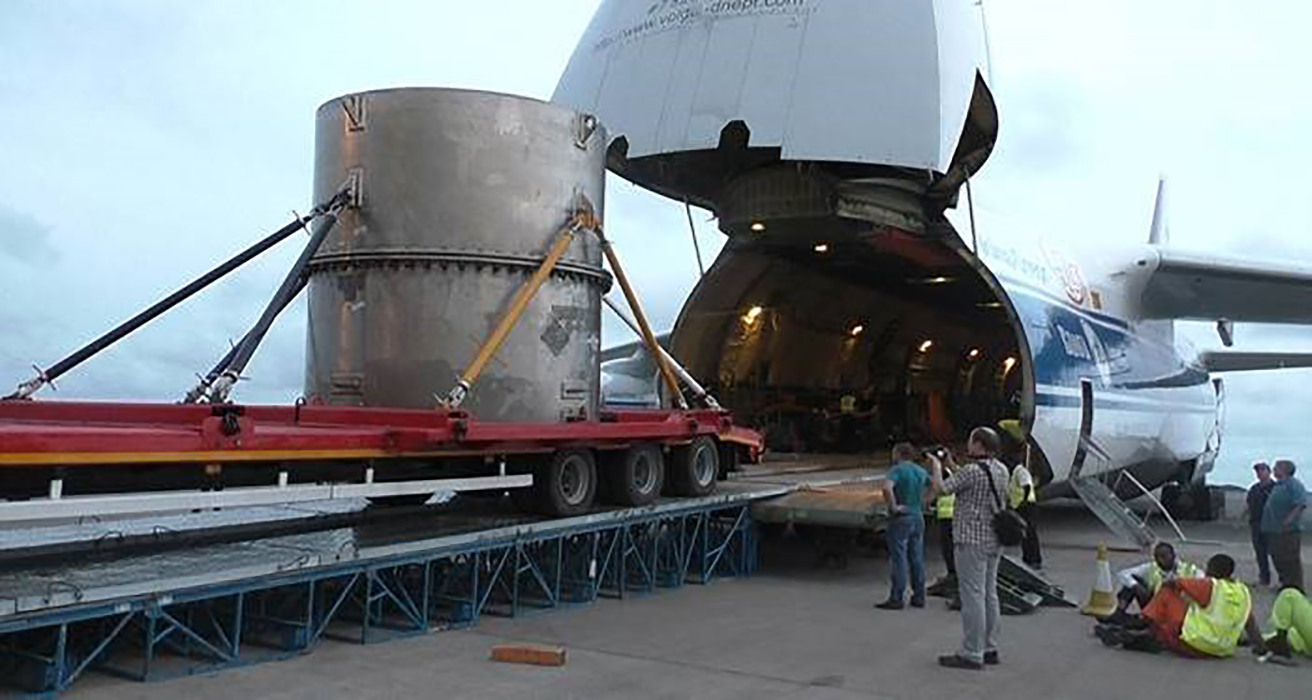
If you would like to learn more about the IAEA’s work, sign up for our weekly updates containing our most important news, multimedia and more.
Countries move towards low enriched uranium to fuel their research reactors
Laura Gil

Secured high enriched uranium being loaded for transport. (Photo: GAEC)
Almost 3500 kg of high enriched uranium (HEU) has been removed from research reactor sites worldwide over the last few decades as part of global efforts supported by the IAEA. Upon the request of Member States, the IAEA has assisted with the conversion of research reactor fuels to low enriched uranium (LEU) in order to reduce the proliferation risks associated with HEU, which contains more than 20% fissile uranium-235.
While most research reactors were built in the 1960s and 70s with technology that required HEU to perform experiments intended for scientific research, today much of this research can be carried out using LEU, in which the concentration of radioactive uranium-235 is below 20%.
“The international community has successfully provided technological solutions for converting HEU fuel to LEU fuel in research reactors,” said Thomas Hanlon, Nuclear Engineer Expert at the IAEA. “The trick is to do this without compromising the scientific research.”
Today, about 220 research reactors operate across 53 countries, and 171 of these reactors were constructed with an HEU core. Seventy-one HEU fuel reactors have been converted to LEU since 1978. Nuclear power reactors, which are used to generate electricity, run on LEU.
The IAEA has supported HEU to LEU fuel conversions or HEU repatriations in Austria, Bulgaria, Chile, China, the Czech Republic, Georgia, Ghana, Hungary, Jamaica, Kazakhstan, Latvia, Libya, Mexico, Nigeria, Poland, Portugal, Romania, Serbia, Ukraine, Uzbekistan and Viet Nam. The IAEA has supported HEU minimization through technical cooperation projects, fact-finding missions, coordinated research projects, technical and consultancy meetings and procurement assistance.
With less enrichment, we are reducing the attraction to the material and making the world better.
Learning from others
A recent case is that of Ghana, where — with IAEA support — the successful conversion of their Ghana Research Reactor-1 (GHARR-1), a miniature neutron source reactor (MNSR), in 2017 turned the country into a case study for other MNSR operators. The Ghana Atomic Energy Commission, or GAEC, has built an international MNSR training facility that allows trainees from other countries to practice extracting mock HEU from the reactor vessel.
“With less enrichment, we are reducing the attraction to the material and making the world better,” said Benjamin Nyarko, Director-General of GAEC, adding that the conversion from 90.2% enriched uranium to 13% was accompanied by technological change that has led to an increase in the reactor’s power by over 10%.
In 2018, Nigeria’s only operating research reactor, Nigeria Research Reactor-1 (NIRR-1), underwent HEU removal and conversion to LEU. The IAEA supported in the conversion as well as in training the relevant personnel and sharing other countries’ experience. To practice converting the reactor, Nigerian experts conducted a dry run of HEU removal in Ghana’s training centre. After the conversion of Nigeria’s reactor, there are no more HEU-fuelled research reactors in Africa.
Conversion requires highly trained personnel and equipment. The most complex step in the process is often transporting the spent HEU, using trucks, ships or planes. Once the HEU fuel reaches its destination, it is either securely stored or diluted to lower enrichment levels.
“In Chile in 2010, we transported approximately 14 kg of HEU to the USA; this was the last of 3 operations that have led to the country being free of this fuel,” said Rosamel Muñoz Quintana, Head of Corporate Communications at the Chilean Nuclear Energy Commission. “It raised great public interest. Specially conditioned trucks and planes were used, and all the necessary security and radiation protection aspects that operations like these require were considered.”
Converting more research reactors to LEU
Work remains to be done. Although 71 research reactors have been converted to LEU, and 28 that were HEU-fuelled have been shut down, another 72 are still powered by HEU. In many cases this is for scientific reasons.
“It takes a lot of creative engineering to figure out how to achieve a similar capacity for the reactor, using LEU in the same space initially designed for HEU,” Hanlon said. “It’s a bit like trying to make a cup of espresso of the same strength you’re used to, using the same amount of liquid in the same container, but with fewer grains of coffee.”

